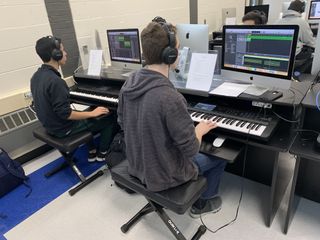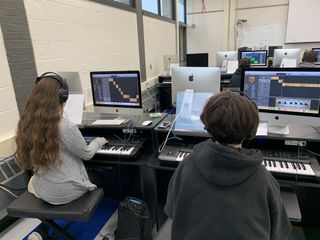One New Jersey district is combining two of its students’ deepest loves—technology and music—to not only amp up band and chorus class, but bring a new level of harmony to subjects throughout the curriculum.
Who: Dr. Christie Riso, Satz Middle school Music teacher and Band Director
Christina Nigro, Satz Middle school Music teacher and Chorus Director
Where: Holmdel Township School District, Monmouth County, NJ
What: Enhancing Music Class with Soundtrap and other Tech
In today’s world, students are very fluent in technology, and very into today’s music as listeners. All the different tech platforms available give them so much access.
Combining the two was inevitable in order to reach students who are nonmusic majors. We created a curriculum that would make learning music relevant, and something that they can eventually use in real world jobs. Soundtrap is a program similar to Garage Band, used in the music industry. (When News 12 came to visit they told us that this program is even similar to their film editing program.)
We also offer advanced middle and high school courses: Music Tech I and Music II classes (Music Tech I class uses GarageBand, Music Tech II uses Logic Pro which is professional sequencing program). If students come into high school already having some background, we will be able to go deeper into composition/orchestration techniques as well as mixing/mastering techniques. We're hoping that having more students exposed to creating music with technology in the middle school will encourage more students to participate in high school.
Positive Results
Our students were excited and started to create music immediately using the vast sounds and loops included with the program. Then we started to use the musical instruments in the program to create music from scratch, recording real musical instruments in the classroom.
We have created mindful meditation music projects for the entire district to use, a loop ABA song, personal podcasts with music and sound effects, and Mashups like a Radio DJ by importing mp3s and mixing songs.
Biggest Challenge
SoundTrap can be accessed from any computer, laptop or even a downloadable app on your phone and works well with Google classroom (all projects can be exported as mp3 and uploaded). Of course, in any new program there are some challenges—the usual issues with wifi, program glitches, students forgetting to save their work.
It’s also hard getting quiet recordings when the entire class is working on a project with microphones. Students would work in a quiet section of the hallway to record with the microphones and then rotate so other students could have a chance. We hope to create a small recording studio for this purpose.

Pro Tips
Don’t be afraid to make mistakes, and to let the students figure things out by exploring the program. It helped them get fluent in the music technology very quickly.
Try combining the music tech into other subjects. Our students created their own rap song using lyrics from poems suggested by Mrs. Lisa Imbro, an English teacher. Game Design teacher, Christen McCafferty, is working with the class to create music to accompany games students are designing. Another project is Changing a Nursery Rhyme into a Horror Story, done by creating the soundtrack and then adding images using Adobe Spark.
Finding Funding
There is a free one month SoundTrap trial that you can use to see if it will benefit your school. We used that first to show its benefits and then had it transferred over to a full program once the district music budget paid for it. (All the student’s work remained in their accounts and were just transferred into the school version.)
- Soundtrap Music Program
- Adobe Spark
- Garage Band
- Logic Pro
- Chromebooks
- Google Classroom


